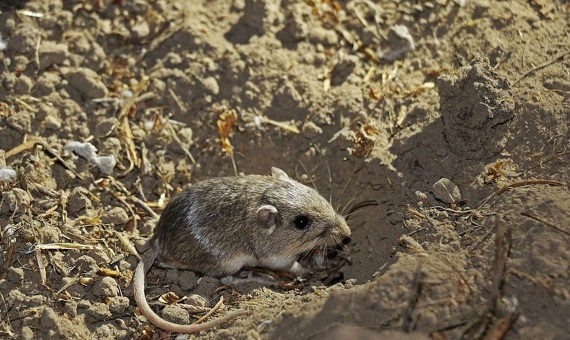One day, when Eric Benton was a little boy, his father brought home a new pet, a tiny little mouse in a cage. “It was an small, adorable little creature,” Benton recalls for OpenMind. He also remembers something especially striking about that little animal, a pocket mouse of the Perognathus longimembris species, which is that it never drank water. “It got all the water it needed from the seeds that we fed it,” he says. And precisely this trait, along with the resistance of this species to stress, was one of the advantages that led the companions of that pet to be chosen for an unusual mission: to travel to the Moon.
That happened back in 1972. Today Eric Benton is a radiation physicist at an Oklahoma State University laboratory named after his father, Eugene V. Benton, then a researcher at the University of San Francisco, and one of those responsible for the experiment that brought five mice to the Moon on the Apollo 17 mission to study the effects of cosmic radiation on the body. One of the candidate rodents who finally failed to earn its wings was the one that comfortably lived out his days in the Benton home.

From December 7 to 19, 1972 the mission that wrapped up the Apollo lunar program took place, until now the last trip made by humans to our satellite. It was also the first and only time a scientist stepped on the Moon, geologist Harrison Schmitt. He and his companions, Eugene Cernan and Ronald Evans, brought back 111 kilos of moon rocks. But geology was not the only science taking place on that mission, nor were the three astronauts the only living beings on board: travelling along with them were five mice —four males and one female— called by the scientists A3326, A3400, A3305, A3356 and A3352, but which the astronauts renamed Fe, Fi, Fo, Fum and Phooey, alluding to the giant’s rhyme in the fairy tale Jack and the Beanstalk.
The radiation meters
The possible damage from cosmic radiation on the organism has been a concern since the beginning of manned space travel. “When you consider how complex a living cell is and then pass a high energy particle through it, the number of ways that particle can damage the cell is enormous,” Benton sums up. “Researchers at the time had only a rudimentary idea of the complexity of the problem.” In fact, during the Apollo program scientists were still faced with the difficulty of understanding certain phenomena related to this exposure, such as the flashes of light that astronauts saw in the darkness of the cockpit and that were actually produced by the effect of radiation inside their own eyes.
Thus was born the idea of the Biological Cosmic Ray Experiment, or Biocore. According to Benton, “the Biocore experiment was one of the first radiation experiments to use live organisms, rather than cells, seeds, etc. and was quite ambitious for its time.” Benton’s father and fellow scientists implanted dosimeters (radiation meters) under the scalps of the five mice in order to detect the trajectories of heavy cosmic ray particles in the brains of the animals.

The mice travelled into space in compartments constructed of tubes inside an aluminium container, with a sufficient food supply, temperature control and a reserve of potassium superoxide that absorbed the CO2 from their respiration and provided them with fresh oxygen. One of the animals probably died at the beginning of the mission, for unknown reasons not related to radiation. The other four remained alive, circling around the Moon with Evans, the pilot of the command module, while his companions Cernan and Schmitt descended to the surface. Thus, the four little rodents shared with Evans the record for the living beings that have orbited the Moon the most, with a total of 75 orbits in 147 hours and 43 minutes.
On their return to Earth, the mice were examined by scientists. “This information was then used by radiobiologists to isolate that area of the mouse brain where the cosmic ray particles interacted with the tissue and look for damage,” says Benton. The researchers found lesions on the scalp and liver of the animals, but apparently they weren’t related to cosmic radiation. In contrast, no significant damage was found to the mice’ brains, eye retinas or other organs.
A necessary step for radiobiology
The definitive conclusions of the Biocore experiment were published in 1975, but they were not very revealing: “The absence of demonstrable lesions in the brain leaves unresolved the degree of vulnerability of brain tissue to this source of radiation,” wrote Eugene Benton and his collaborators, Webb Haymaker, Bonne Look and Richard Simmonds, at NASA’s Ames Research Center.
“It was difficult to draw many conclusions from it,” says Benton. However, the physicist adds that Biocore fulfilled a valuable objective by suggesting to scientists that, in general, the results obtained were similar to those observed using particle accelerators in terrestrial laboratories, “demonstrating that this kind of ground-based research was a good analogue for much more difficult space experiments.”

“Biocore was a limited but necessary step in our growing understanding of the complexities of radiobiology,” concludes Benton. The researcher says that in the half a century since the Apollo programme began, enormous progress has been made in this field thanks to the progress of molecular biology and the understanding of genetics.
And yet, much remains to be learned about the effects of ionizing radiation on the body during long space travel, an area of study that is once again in the spotlight thanks to NASA’s Artemis program that aims to resume manned missions to the Moon in the next decade. Perhaps now more than ever is the time to remember not only the researchers whose pioneering work will enable future astronauts to travel safer, but also the great service rendered by little Fe, Fi, Fo, Fum and Phooey towards this goal.
Javier Yanes
Comments on this publication